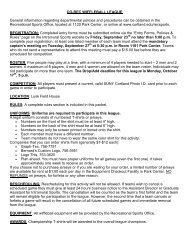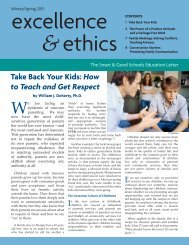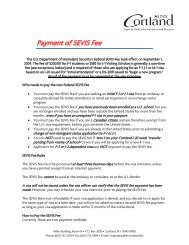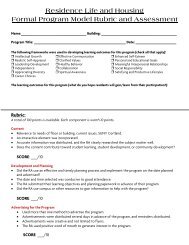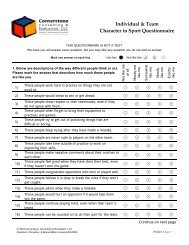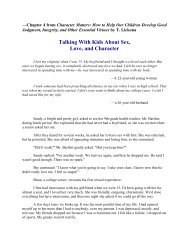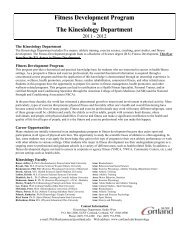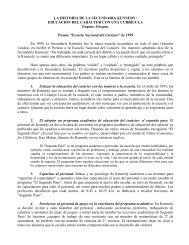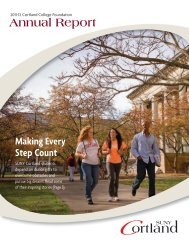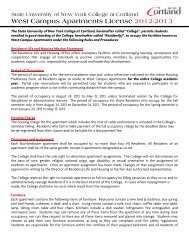Prevention of Substance Abuse Among Adolescents By Meaghan ...
Prevention of Substance Abuse Among Adolescents By Meaghan ...
Prevention of Substance Abuse Among Adolescents By Meaghan ...
Create successful ePaper yourself
Turn your PDF publications into a flip-book with our unique Google optimized e-Paper software.
seems as though what is being taught to students does not have animpact on their decision making when it comes to the use and abuse <strong>of</strong>drugs and alcohol. "Society seems at present too <strong>of</strong>ten ill-informed ormisinformed <strong>of</strong> many <strong>of</strong> the facts regarding the effects <strong>of</strong> alcohol anddrugs" (Edwards viii). It is imperative that we take the time now to createa more informed society for tomorrow. Some believe that any positiveeffects from these programs have been with respect to changes inknowledge not in changes in behavior. "Most <strong>of</strong> the existing programsthat are in place to educate students assume that knowledge gain will behelpful in changing behavior and thoughts, an assumption that can not bemade justifiably with any degree <strong>of</strong> certainty" (Sliksman 180). It isextremely important that programs do not teach students simply aboutdrugs and alcohol, which most do, but more importantly about real lifesituations and how to make informed decisions.A number <strong>of</strong> well designed studies have discovered that preventionprograms with community involvement have succeeded in reducing druguse in adolescents (Cuijpers 1). For example, a study conducted by theTransportation Research Institute <strong>of</strong> Michigan examined the effects onsubsequent driving <strong>of</strong> a high school-based alcohol prevention program.The study included a control group and an intervention group with a total<strong>of</strong> 4,385 tenth grade students. The group <strong>of</strong> students in the interventionprogram inevitably showed a significant decrease in the number <strong>of</strong> driving<strong>of</strong>fenses after having taken the class. The findings suggest that a highschool based alcohol prevention program can positively affect responsibledriving. The results indicate the extreme need to start preventionprograms at a young age and extend them beyond the initial exposure todriving (Shope 1). Programs that do not begin until tenth grade, whenmost students are beginning to drive, lose much <strong>of</strong> their effectivenessdue to the late start. A program <strong>of</strong> this nature makes students moreaware not only <strong>of</strong> the affects that drinking has on themselves, but also ontheir surrounding community. In turn this creates a safer community.Another example to represent the importance <strong>of</strong> creating a bridgebetween community and school based substance abuse prevention is astudy conducted by Weill Medical College <strong>of</strong> Cornell University. This studyexamined the effectiveness <strong>of</strong> intervention programs at the middle schoollevel. Rates <strong>of</strong> binge drinking were compared among youth who receiveda substance abuse prevention program at the beginning <strong>of</strong> seventhgrade (1,713 students) and a control group (1,328 students) that did not.The proportion <strong>of</strong> binge drinkers was over 50% lower in the interventiongroup compared to the control group in the follow-up assessments. Thesefindings indicate that school based drug abuse prevention programs
significantly -reduce binge drinking in middle school students (Botvin 1).This is yet another example <strong>of</strong> an effective program that had heavyinvolvement from parents and other community members. Many programshave been examined and dismissed as unsuccessful. There are multiplereasons why this may be the case. First <strong>of</strong> all, the goals <strong>of</strong> a specificprogram may have been unclear so that making an outcome assessmentwas difficult (Milgram 185). Also, the content <strong>of</strong> the program may not meetthe student's needs. If the program is designed for young students and itis taught at a high school level, its effectiveness will decrease and viceversa. Thirdly, the material covered in substance abuse preventionprograms is difficult to teach. The teacher delivering the program may notbe comfortable teaching the material or may not be trained in this specificarea <strong>of</strong> knowledge. Lastly, many times programs may not have a longenough duration to be as effective as possible (Sliksman 179). Manytimes a school system limits the substance abuse education to one levelor one specific period <strong>of</strong> time. An example <strong>of</strong> this would be an educationprogram that is taught solely at the high school level, or a program thatbegins and ends around prom and graduation time. These programs cannot be assessed accurately because <strong>of</strong> their lack <strong>of</strong> comprehensiveness.It is important to reinforce the magnitude <strong>of</strong> the dangers <strong>of</strong> alcohol anddrug use at these specific times, but it is more important to have anextensive program being presented to students at all times. Acurriculum that runs from kindergarten to twelfth grade with a number <strong>of</strong>courses would be the most ideal. Involving community parents to help inreinforcing the dangers <strong>of</strong> drug use would also be very effective forstudents at a very young age. This curriculum would incorporate teachingstrategies for early identification, which will undoubtedly help thosebeginning to be at high risk. It would also continually strengthen healthhabits and answer questions throughout student's pre-teen and teenageyears (Sliksman 181).Most young children may not have an explicit understanding <strong>of</strong> illegalsubstances and their effect on people. Although, it would be completelynaive to believe that children do not know <strong>of</strong> these things. The children athigh risk for substance abuse are the ones who will benefit from theeducation at a very young age. Some may argue that it is dangerous toexpose children to much <strong>of</strong> this information, but by giving children alanguage for it the ones at the highest risk for exposure, willieam thedangers. An elementary school social skills and peer pressure resistancecurriculum for preventing alcohol misuse was developed, implemented,and evaluated by the Department <strong>of</strong> Post Graduate Medicine and HealthPr<strong>of</strong>essions Education at the University <strong>of</strong> Michigan Medical School.Results indicated the intervention was effective in reducing the number
<strong>of</strong> students who experimented with alcohol (Dielman 1). Involving parentsin the education <strong>of</strong> young people helps teachers and the many othereducators involved in prevention programs recognize the appropriateboundaries and limitations regarding how detailed programs should be inrelation to the age <strong>of</strong> the students.Peer leadership is an extremely effective way to teach about drug abuseand ways it can be prevented (Klepp 1). The classroom provides a sitewhere this is possible. "The classroom is a peer group" says Milgram,Adolecent Psychologist (185). It is essential that students interact witheach other to discuss individual beliefs about and encounters with drugsand alcohol and to discuss reasonable positive alternatives in high risksituations. Having strong community based programs creates anenvironment where older students can help to teach younger students.Studies show that targeting middle school aged children and designingprograms that can be primarily be delivered by peer leaders willdrastically increase the effectiveness <strong>of</strong> school based substance useprevention programs (Gottfredson 1). Although parents and oldercommunity members many times may not be considered peers, they canuse personal experiences to advance students knowledge. Theparticipation <strong>of</strong> these community members is a critical component inschool based education.School is by far the finest place for prevention education. It is imperativethat this specialized type <strong>of</strong> education is not simply treated as anotheracademic, but more an interactive class where students have theopportunity to gain a connection with their community. The most effectiveprograms have included a secure community base. To ensure many morepositive outcomes when it comes to prevention programs, it is extremelyimportant to interconnect community with-in school-based programs."Building a bridge between the community and the school helps toreinforce the importance <strong>of</strong> this type <strong>of</strong> education" Milgram 184).Community support is fundamental in any program's success.Works CitedBotvin G.I, KW. Griffin, T. Diaz, M. Ifill-Williams. "Preventing Binge DrinkingDuring Early Adolecence: One and Two Year Follow-Up <strong>of</strong> a SchoolBased Preventive Intervention." Pub Med. 15 Dec 2001. 9 Nov 2003.http://www.ncbi.nlm.nih.gov/entrez/query. fcgi?cmd=retrieve+db=pubmed+ list uids=II>.Botvin G.J., M.A Orlandi, S.P. Schinke. <strong>Substance</strong> <strong>Abuse</strong> in Children and
<strong>Adolescents</strong>: Evaluation and Intervention. California: SagePublications. 1991.Butchart AT., Dielman, S.L. Leech, IT. Shope. "Differential Effectiveness OfElementary School Based Alcohol Misuse <strong>Prevention</strong> Program." PubMed. Aug. 1989.9 Nov 2003.http://www.ncbi.rum.nih.gov/entrez/query.fcgi?cmd=retrieve+db=pubmed+ list ui ds=27>.Cuijepers, P. "Effective Ingredients <strong>of</strong> School based Drug <strong>Prevention</strong>Programs. A Systematic Review." Pub Med. 27 Nov 2001. 17 Nov2003. http://www.ncbi.nlm.nih.gov/entrezlquery. fcgi?cmd=retrieve+db=pubmed+ list ui ds=I>.Edwards, Griffith. Alcohol: The World's Favorite Drug. New YorkSt. Martin'sPress. 2000.Elliott M.R., IT. Shope, T.E. Raghunathan, P.F. Waller. "Long-Term Follow-Up <strong>of</strong> High School Alcohol Misuse <strong>Prevention</strong> Program's Effect OnStudents' Subsequent Driving." Pub Med. 25 mar 2001. 9 Nov 2003.http://www.ncbi.rum.nih.gov/entrez/query.fcgi?cmd=retrieve+db=vubmed+ list ui ds=l1>.Engs, Ruth C. ed. Controversies in the Addiction Field. Dubuque, Iowa:Kendall Hunt, 1990.Fors, Stauat. "School-Based Alcohol and Drug Education Programs Can BeEffective." Engs 167-172.Gliksman, Louis., Smythe, Cynthia. "A Review <strong>of</strong> School-Based DrugEducation Programs: Do We Expect Too Much?" Engs 175-181.Gottfredson, D.C., D.B. Wilson. "Charactersitics <strong>of</strong> Effective School Besed<strong>Substance</strong> <strong>Abuse</strong> <strong>Prevention</strong>." Pub Med. 4 Mar 2003. 17 Nov 2003.http://www.ncbi.nlm.nih.gov/entrez/ query.fcgi?cmd=retrieve+db=pubmed+ list ui ds=I>.




